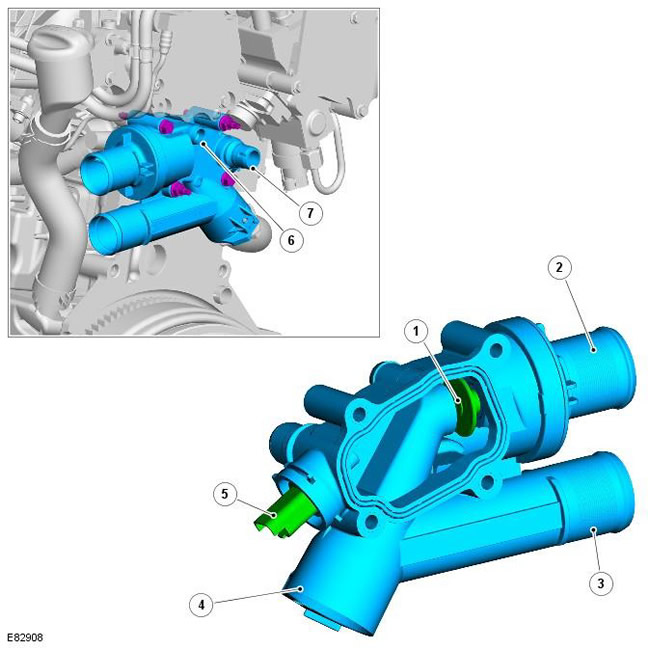
| Pos. | spare part no | Name |
| 1 | - | Thermostatic and bypass valve |
| 2 | - | Upper Radiator Hose Connection |
| 3 | - | Lower Radiator Hose Connection |
| 4 | - | Coolant manifold port to coolant pump housing |
| 5 | - | Engine coolant temperature sensor (EATING) |
| 6 | - | Air outlet connection |
| 7 | - | Feed to heater inlet |
The temperature control module is mounted at the rear of the cylinder head and secured with two stud nuts and two bolts and sealed with an o-ring. The module includes a paraffin-filled thermostat with bypass valve and an ECT sensor. The two ports on the left side of the module allow connection of the upper and lower radiator hoses.
The paraffin filled thermostat is located in the upper radiator hose port. The large diameter port on the lower right side connects the module to the coolant manifold. The two small diameter outlet ports on the front of the module serve to connect the supply hose to the heater core and the air outlet line to the expansion tank.
The temperature control module helps ensure that the engine warms up quickly to normal operating temperature by blocking the return of coolant from the engine to the radiator. During the engine warm-up phase, the thermostat is closed and the bypass valve is open. The bypass port allows coolant to circulate through the engine's closed circuit - coolant pump, climate control heater circuit, and EGR heat exchanger.
As the coolant temperature rises, the thermostat opens and the bypass valve closes. Hot coolant returning from the engine can flow from the temperature control module to the radiator through the open thermostat and top hose. The coolant returning from the radiator travels down the bottom hose to the coolant pump through the coolant manifold.
The thermostat starts to open at 83°C and closes completely at 91°C.
An ECT sensor is located in the temperature control module. It is fixed in the body with a clamp. ECT sensor provides engine coolant temperature signal to engine control module (ECM). The signal is used by the ECM to control the operation of the two cooling fans. For more information see the chapter: Electronic Engine Controls - 2.2L Diesel (303-14 Electronic Engine Controls - 2.2L Diesel, Description and function).
In addition, the ECM sends an ECT signal on the CAN bus to the central electrical junction box (CJB). The CJB transmits an ECT signal on the medium speed CAN bus to the instrument cluster to provide an indication of the coolant temperature on the appropriate gauge. For more information, see chapter: Instrument panel (413-01 Instrument panel, Description and function).
Comments on this article